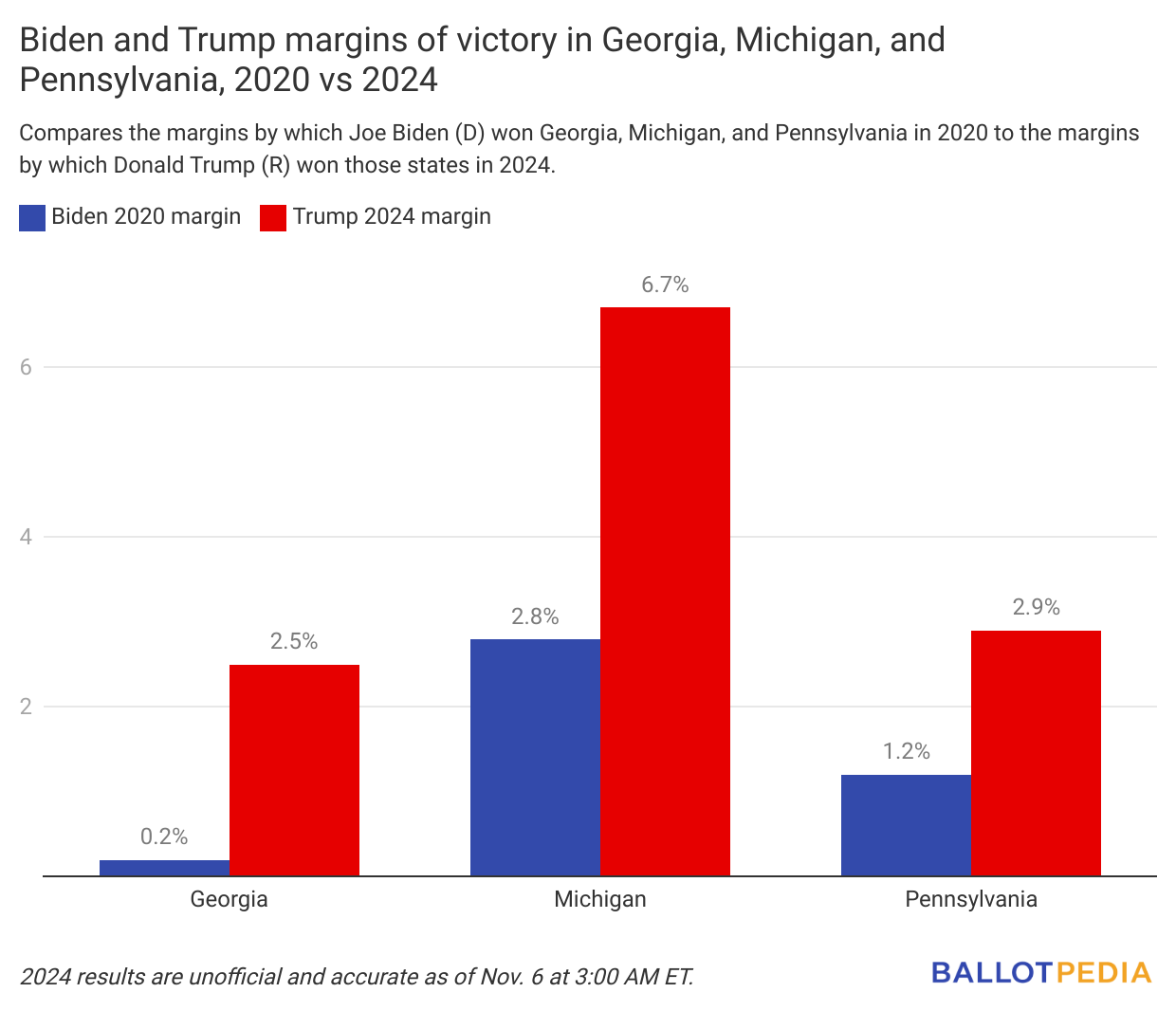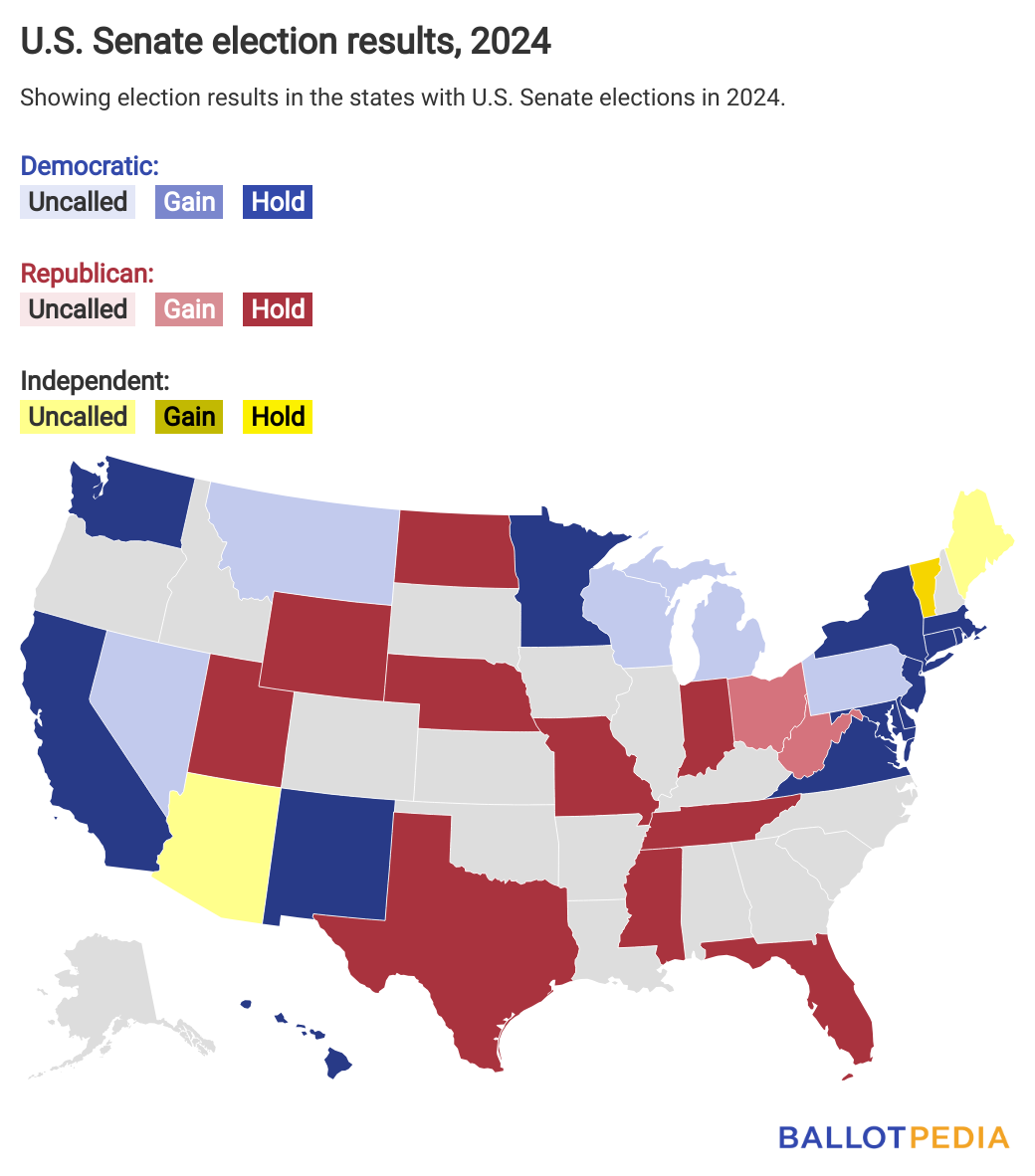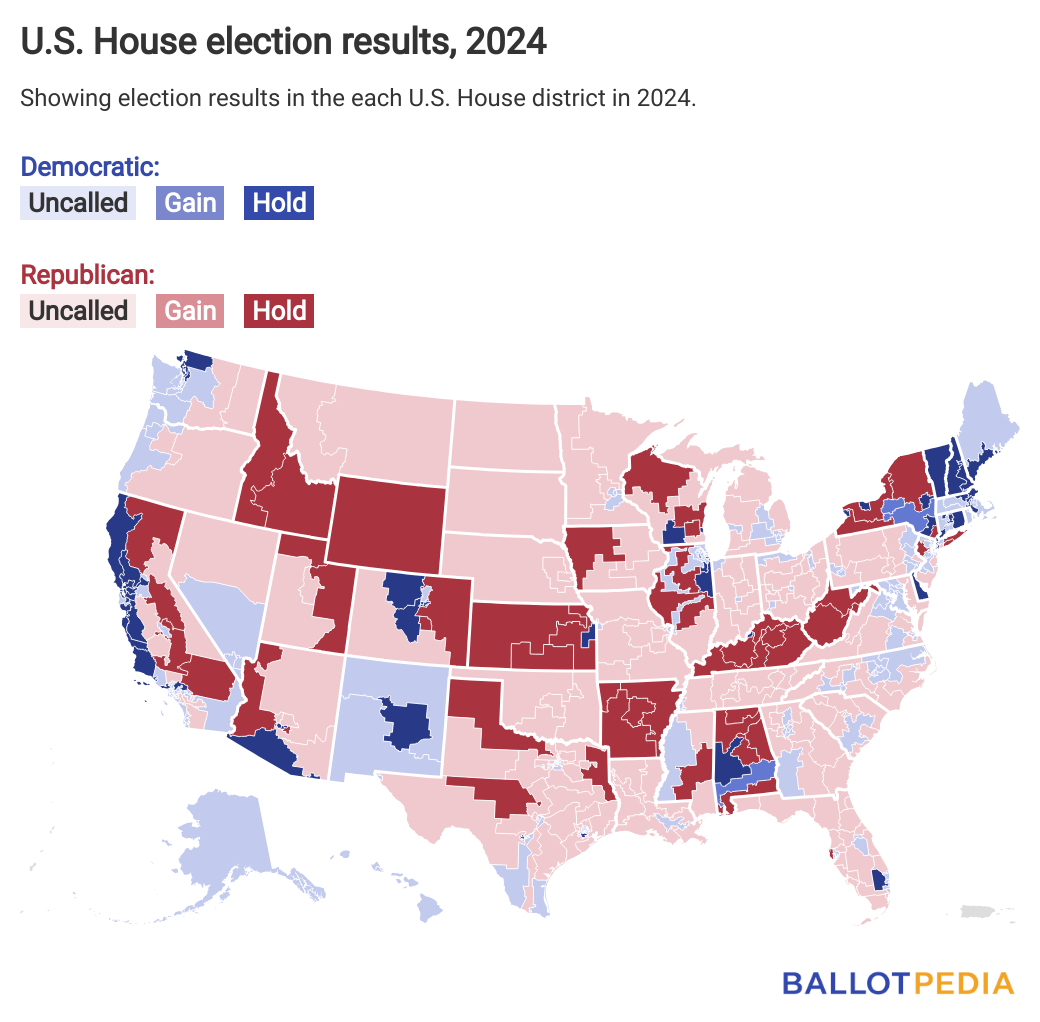|
|
Welcome to the Wednesday, November 6, Brew.
|
|
|
By Samuel Wonacott
|
Good morning! We hope you got some sleep last night. If you stayed up following the results, you likely have a good sense of what happened. If you hit a normal bedtime, this may be one of your first updates and we hope to give you a general summary of results from across the country. Visit Ballotpedia all day today for updated results as states continue to process ballots. Note—the results in this email are current as of 3am EST.
We’ll give you a rundown on:
-
The presidential election
-
Noteworthy ballot measures
-
Both chambers of Congress
-
State governments
-
State courts
|
|
BALLOTPEDIA |
|
|
|
|
|
|
Who won the presidency?
|
|
|
|
|
|
|
If you are reading this newsletter, you probably already know where the presidential race stands.
As of this writing, some media outlets—like Fox News and Decision Desk HQ—had called the election for former President Donald Trump (R). Others, such as The New York Times and the Associated Press, had not called the race. Trump is projected to win the popular vote.
Trump gave an acceptance speech to his supporters at around 2:30 a.m. Vice President Kamala Harris (D) chose not to address supporters gathered at Howard University, in Washington, D.C.

You can find our most up-to-date information on the presidential race here. We’ll have more analyses about pivot counties and more in the days ahead. |
|
|
|
|
|
|
|
|
|
|
What are the notable ballot measure results?
|
|
|
|
|
|
|
Yesterday, voters in 41 states decided on 146 statewide ballot measures. More than $1 billion was spent on ballot measure campaigns this cycle. As of this writing, voters have approved 52 and defeated 19. The rest are uncalled.
Here are some notable results:
Abortion
Voters decided 11 abortion-related ballot measures—the most on record for a single year. Groups supporting and opposing the measures spent around $273 million. As of this writing, six approved measures provided a state constitutional right to abortion. One prohibited abortion after the first trimester. One other defeated measure would have provided a state constitutional right to abortion.
-
In Arizona, voters approved Proposition 139 with 62.7% of the vote, which amended the state constitution to provide for the right to an abortion.
-
In Florida, Amendment 4 was defeated, receiving 57% of the vote. The amendment would have provided for a state constitutional right to abortion. Florida requires a 60% vote to approve constitutional amendments, which is a higher threshold compared to other states deciding on abortion measures.
-
In Colorado, voters approved Amendment 79 with 60.9% of the vote. It provides for the right to abortion in the state constitution and allows the use of public funds for abortion.
-
Voters in Maryland approved Question 1 with 74.5% of the vote. It establishes a right to reproductive freedom, defined to include "the ability to make and effectuate decisions to prevent, continue, or end one's own pregnancy," in the Maryland Constitution.
-
In Missouri, voters approved Amendment 3 with 53.2% of the vote. It provides for a right to abortion in the state constitution. This is the first time voters approved a right-to-abortion amendment in a state with a six-week abortion ban.
Marijuana and psychedelics
-
In Florida, Amendment 3, which would have legalized marijuana for recreational use, was defeated. It received 55.7% of the vote. In Florida, a 60% vote is required to pass constitutional amendments. Amendment 3 was the most expensive marijuana ballot measure on record, with more than $186.6 million raised between supporters and opponents.
Education
-
In Florida, voters rejected Amendment 1, which would have changed school board elections from nonpartisan to partisan. It received 54.8% of the vote, short of the 60% threshold to pass constitutional amendments.
-
In Kentucky, voters rejected Constitutional Amendment 2, which would have allowed the legislature to provide funding to non-public school students. The vote was 34.9% 'Yes' to 65.1% 'No.'
Voting-related and noncitizen voting
-
Voters approved constitutional amendments in eight states (Idaho, Iowa, Kentucky, Missouri, North Carolina, Oklahoma, South Carolina, and Wisconsin) to prohibit state and local governments from allowing non-citizen voting. Approval ranged from 62% in Kentucky to 86% in South Carolina.
-
In Missouri, voters approved a constitutional amendment to ban ranked-choice voting (RCV) and prohibit the state or local governments from allowing noncitizens to vote. It received 67.3% of the vote.
-
Voters in Washington, D.C., Oak Park, Illinois, and Peoria, Illinois, approved measures adopting or encouraging the adoption of RCV. Measures in Richmond, California, and Bloomington, Minnesota, remain uncalled.
Environment
-
In Washington, voters rejected Initiative 2117, which would have banned cap and trade carbon tax credit programs and repealed the 2021 Washington Climate Commitment Act (CCA). The CCA is a state law that provides for a cap and invest program designed to reduce greenhouse gas (GHG) emissions by 95% by 2050.
Criminal justice
-
In California, voters approved Proposition 36, which increases penalties and sentence lengths for certain crimes—such as theft and shoplifting of goods valued at no more than $950 and certain drug possession offenses. It received 70.5% of the vote.
Minimum wage
-
In Massachusetts, voters rejected Question 5, which would have increased the minimum wage for tipped employees to meet the standard minimum wage. A minimum wage increase ballot measure has not been rejected since 1996.
-
In Missouri, voters approved Proposition A, which will increase the minimum wage to $15/hour in 2026 and require employers to provide a minimum of five to seven paid sick days (depending on business size). It received 58.1% of the vote.
|
|
|
|
|
|
|
|
|
|
|
Who controls the U.S. Senate?
|
|
|
|
|
|
|
Republicans are projected to win control of the U.S. Senate, having at least won two seats previously held by Democrats. Going into the election, Democrats held a 51-49 majority in the U.S. Senate. Democrats were defending three Senate seats in states Donald Trump (R) won in the 2020 presidential election. Republicans were not defending any Senate seats in states Joe Biden (D) won in 2020.
Republican pickups
 |
|
|
|
|
|
|
|
|
|
|
Who controls the U.S. House?
|
|
|
|
|
|
|

Going into the election, Republicans held a 220-212 majority in the U.S. House with three vacancies. All 435 seats were up for election, with Democrats needing to gain a net of six districts to win a majority in the chamber. Republicans could only lose a net of five districts and maintain their majority or pick up one or more districts to increase their majority. In 2022, Republicans gained a majority in the U.S. House, winning 222 seats to Democrats' 213. The control of the U.S. House is pending races that have not yet been called.
-
In New York, Josh Riley (D) defeated incumbent Marcus Molinaro (R) in the general election for New York's 19th Congressional District.
-
In New York, John Mannion (D) defeated incumbent Rep. Brandon Williams (R) in the general election for New York's 22nd Congressional District. As of 11:28 PM, Mannion received 53.8% of the vote to Williams' 46.2%.
-
In Alabama, Shomari Figures (D) defeated Caroleene Dobson (R) in the general election for Alabama’s 2nd Congressional District. Incumbent is Barry Moore (R), who did not run for re-election.
|
|
|
|
|
|
|
|
|
|
|
What is the status of trifectas and triplexes?
|
|
|
|
|
|
|
State legislatures
Heading into the election, Democrats controlled 41 chambers and Republicans controlled 56. A bipartisan coalition controlled the Alaska House and Alaska Senate. Nineteen state legislative chambers had guaranteed majorities due to the lack of major party competition—six for Democrats and 13 for Republicans.
Keep reading
State executives
|
|
|
|
|
|
|
|
|
|
|
What happened in state supreme court elections?
|
|
|
|
|
|
|
WThirty-three states held state supreme court elections this year. In total, 82 of the 344 seats on state supreme courts were up for election. Of the courts up in 2024, Democrats had a majority in nine states and Republicans had a majority in 24 states.
-
In Kentucky, Pamela R. Goodwine won election to the 5th District position on the Kentucky Supreme Court, defeating Erin Izzo. While this was a nonpartisan race, Goodwine received endorsements and donations from Democratic officials, and Izzo received the same from Republican groups. As a result of this election, the Kentucky Supreme Court went from having a four-member Republican-affiliated majority to a split make-up, with three members affiliated with the Democratic Party, three affiliated with the Republican Party, and one member whose affiliation was unknown.
-
In Ohio, Republicans maintained their majority on the state supreme court. Dan Hawkins (R) defeated Lisa Forbes (D) in the race for the open seat on the Ohio State Supreme Court. Hawkins received 55.6% of the vote to Forbes' 44.4%. Megan Shanahan (R) defeated Michael Donnelly (D) in the race for Donnelly's seat. Shanahan received 55.7% of the vote to Donnelly’s 44.3%. Joseph Deters (R) defeated Melody Stewart (D) in the race for Stewart's seat. Deters received 55.2% of the vote to Stewart’s 44.8%.
-
In Oklahoma, voters removed Justice Yvonne Kauger in a retention election with 50.3% voting against her. Kauger has served since 1984. No justice in Oklahoma history had ever been defeated in a retention election. Voters retained Justices James Edmondson and Noma Gurich with 51% and 50.3%, respectively. Although Oklahoma has had a Republican trifecta since 2011, Democratic governors appointed all three justices. Republicans hold a 5-4 majority on the court. Gov. Kevin Stitt (R) will select a replacement.
|
|
|
|
|
|
|
|
|
|
|
Resources for following results this week (and beyond)
|
|
|
|
|
|
|
More races will be called in the coming days. We'll keep you updated in The Daily Brew, but in the meantime, visit the links below for ongoing updates and answers to questions you may have about post-election processes.
Race results
Ballot measure results
Election help desk
|
|
|
|
|
|